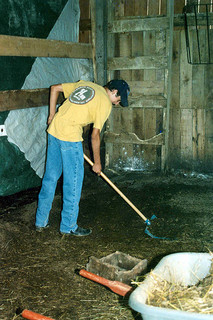
Photo credit: National Institute for Occupational Safety and Health (NIOSH) on Flickr
It’s “always a potential safety problem for workers.”
Methane is an odourless, colourless gas – and “inhaling too much of it can result in suffocation due to insufficient oxygen,” reads a safety alert from WorkSafeBC. “This has been, and likely will continue to be, a known hazard when working with animals on a farm.”
Best practices for people working with or near manure
BC’s Farm and Ranch Safety and Health Association (FARSHA) points out that “the manure-handling system on every farm is different.”
In Confined Spaces – Deadly Spaces, WorkSafeBC recommends “it is especially important to have a qualified person do the hazard assessment and safe entry procedures for the manure pit and associated structures on your farm.”
In the factsheet Manure Gas Dangers, the Farm Safety Association describes how methane “…tends to accumulate at the top of manure pits” and causes asphyxiation at high levels.
“The main hazard is its flammable, explosive nature. Methane is extremely difficult to detect without gas detection instruments because it is odorless but it should be anticipated as being present in all manure storage areas.”
The AFAS recommends that farmers “maintain adequate ventilation in all confined areas where livestock are housed or livestock waste is stored. This is especially true if the manure is being agitated, since agitation causes a rapid release of gases. Even with the facility’s ventilation system operating, high levels of toxic gases can accumulate quickly. Ventilation recommendations are available from a number of sources.”
This NIOSH alert, Preventing Deaths of Farm Workers in Manure Pits, describes “seven deaths from asphyxiation (suffocation) that occurred during two incidents involving entry into manure pits.”
” An urgent need exists to inform farm owners and workers about the dangers of enter such pits, where oxygen-deficient, toxic and/or explosive atmospheres often result from fermentation of the wastes in confined areas. These hazards have been known for several years,” reads the NIOSH alert.
“However, recent NIOSH investigations conducted under the NIOSH Fatal Accident Circumstances and Epidemiology (FACE) Program suggest that farm workers are unaware of the danger, and many deaths continue to occur as a result of entry into manure pits.”



Do you know if the safety alert is due to a fatality or a non-fatal incident? I’m hoping the last sentence indicates that the worker was exposed, yet in a non-fatal way, and that they’re going to be okay. Thanks again for another interesting blog entry, Susan!
— Nicole, Airdrie, AB.